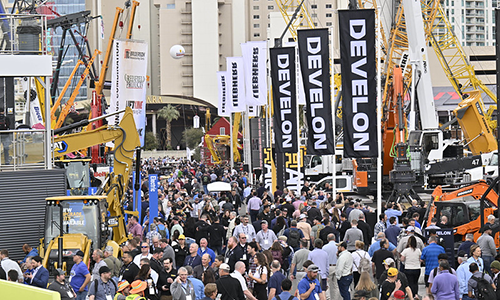The faster and more accurately a construction equipment operator can work, the better the results will be from both an economic and environmental standpoint. The challenge is that operators are human, and humans are prone to human error. Optimum efficiency isn’t easy to achieve through operator skill alone—especially at a time when more new operators are coming into the workforce.
Digital control is one construction equipment innovation that directly addresses this challenge. In fact, by “taking control” of certain equipment tasks and modes of operation, digital control actually turns this challenge into an enormous opportunity.
AEM’s new report, Benefits of Construction Equipment Technologies and their Impact on Society, highlights the many benefits of digital control systems, namely:
- Easier-to-use equipment
- Increased operator speed
- Increased accuracy
- Reduced operator stress and fatigue
- Improved safety
- Reduced fuel use and emissions
“The operator of a highly productive piece of construction equipment has to be extremely effective today,” said Per Nilsson, industry market manager at AEM member company Parker Global Mobile Systems. “If there are a lot of buttons to push and things to think about, the chances of making a mistake are higher. But if you have smart controls, especially ones that are multi-purpose, operation becomes easier and more efficient for anybody.”
The nervous system of modern construction equipment
Digital control utilizes a system of sensors and computers to reduce the number of variables an equipment operator must control. Much like a human’s nervous system, software (brain) transmits signals to the machine’s various organs (engine, transmission, wheels, work tool, etc.) based on what it senses.
Power management is one area where digital control has widespread applicability.
“Say you have a piece of equipment with a 100-hp engine,” said Dr. Germano Franzoni, senior systems engineer at Parker Global Mobile Systems. “With digital control, you could spec the pumps for 150 to 200 hp, and then actively manage the power so you never exceed the limit of the engine. Speed can be reduced when there’s a high load. When the load is lower, speed can be faster. That improves machine productivity while also preventing the engine from stalling.” The beauty is that it all happens without the operator even realizing.
In addition to engine operation and power management, digital control is also having a positive impact on other subsystems within a piece of construction equipment.
“When you’re talking about subsystems, you’re talking about portions of a machine or certain components that are digitally controlled,” said Matt Christensen, vice president of North American sales and application engineering at Poclain Hydraulics. “Pumps, motors and valves have traditionally been hydraulically controlled with no level of digital connectivity. So there never was any communication or feedback. That has changed. With digital control, tasks like bucket or blade leveling can now be done automatically. What used to require a very experienced operator to perform correctly can now be done automatically.”
Along with specific machine work tools, Christensen said other subsystems like transmissions and traction can also be digitally controlled. With respect to traction control, an algorithm in the software knows when to direct torque to the wheels that have traction.
Anti-stall technology is another example. A system of motors, sensors, pressure transfers and software intelligence help manage engine power in parallel with ground speed requirements so an engine doesn’t stall when climbing over uneven terrain, for example.
All of this type of semi-autonomous operation makes things easier on equipment operators. New operators can become proficient faster, and experienced operators can become even more productive than ever before.
Taking control of safety
Digital control systems also play a hand in enhanced jobsite safety. “Safety is an extremely powerful feature,” Nilsson said. “Anytime you can enhance safety without interfering with the operator, that’s an important advancement. Digital control does that.”
First of all, more accurate equipment operation reduces the chances of accidents, striking underground utility lines, etc. Secondly, easier equipment operation results in less operator stress and fatigue, which can also reduce the likelihood of accidents.
There are also digital control systems that have been specifically created to enhance machine safety. “It could be something as simple as an alarm, or something that could change or inhibit the response of the machine,” Christensen explained. “It’s about making machines smarter and more aware through features like interlocks and obstacle detection.”
“Let’s say you have an excavator in the area of a 10,000-volt powerline,” Nilsson used as an example. “You can fence the machine in so it can’t get too close to that powerline. Similarly, you could geofence an area so a machine can’t get too close to a creek or other body of water, or enter an area with unsafe terrain. Smart digital control makes this possible.”
Indirect impact on environmental imprint
Safer, more productive equipment can also lead to jobsites that are more environmentally sensitive. “Jobs done faster, safer and more precisely lead to less fuel consumption, emissions and noise,” Christensen said.
There are a couple key elements impacting noise output. “First, as we’re able to use digital control to better control the conversion of power and overall machine efficiency, there is often an opportunity to downsize the engine used on that machine,” Christensen explained. Going from a 70-hp engine to a 50-hp engine, for example, generally results in much quieter operation. Doing so also helps improve fuel economy and reduce emissions.
“Secondly, gaining better control over components like pumps and valves also allows for reduced noise,” Christensen continued. “Lost hydraulic energy is generally lost in two ways, heat and noise. If we can better control these subsystems, such as through digital control, we can typically recapture a lot of that lost energy.”
“When you’re talking about subsystems, you’re talking about portions of a machine or certain components that are digitally controlled. Pumps, motors and valves have traditionally been hydraulically controlled with no level of digital connectivity. So there never was any communication or feedback. That has changed. With digital control, tasks like bucket or blade leveling can now be done automatically. What used to require a very experienced operator to perform correctly can now be done automatically.” -- Poclain Hydraulics Matt Christensen
Digitization is about assisting, not replacing
The digitization of numerous equipment systems—from the engine to the work tool—also allows for the leveraging of real-time data to improve fleet management and equipment maintenance.
Equipment managers can monitor equipment usage and diagnostic codes remotely, helping to more proactively schedule maintenance before costly breakdowns occur. Furthermore, software updates can be performed remotely at the most opportune times, avoiding the need to take equipment out of production. All of this helps lead to an equipment fleet that can truly function at a peak level of efficiency.
“Sensoring for next-generation control systems provides for much better equipment service,” Nilsson said. “Troubleshooting gets a lot easier when you can see particular errors and faults with particular components. Service technicians can pinpoint issues right way. Better yet, they can receive a message over the connectivity piece so they can bring the right parts to the jobsite, helping speed up the repair and improving uptime even more.”
Digital control systems also give equipment manufacturers an opportunity to better standardize control systems across product lines, which results in streamlined componentry. Christensen points to the automotive industry of the 1980s and 90s to draw a parallel to what is happening in the construction equipment industry today.
“An automotive manufacturer used to have eight to a dozen different engines and drivetrains for its line of vehicles that model year,” Christensen said. “Now a manufacturer is often using four or less. A single engine or transmission is being standardized for use in not only a car, but also a mid-size SUV and mini-van, for example.
“The same approach can be used for off-road equipment,” Christensen continued. “You may have a range of machines that have different power and performance requirements. When subsystems like engines, transmissions and pumps are controlled digitally, you no longer need to have vastly different components. You can simply tune those different subsystems to do different things and perform in different ways. That can reduce the number of drivetrains you may need across a product offering.”
One consideration with digital control systems is who owns the controller. Companies like Parker and Poclain offer cutting-edge control solutions, but some equipment manufacturers also have capabilities in that area. The consensus is that control providers and equipment manufacturers must work in close collaboration to develop the right solutions for the right applications.
“It’s about helping the operator, but not in a way that interferes with the operator,” Franzoni said. “The operator still wants to be in control, maintaining the ability to decide what the machine does. The digital control system is there to assist, not completely replace.”
As digital control continues to evolve and become even more prolific, Christensen anticipates seeing increased activity around AI (artificial intelligence) in coming years. “Eventually, we’ll get to a point where we have machine learning, or adaptive learning, as a machine works with a particular operator or in a certain application,” Christensen said. “That machine, through AI, will begin to learn and adapt its performance relative to the conditions.”
Whether right now or several years down the road, Franzoni said it’s also important to recognize that digitization of construction equipment can become a double-edge sword. Populating machines with too many electronic parts can increase service complexity. Simple, mechanically driven machines can be relatively easy to fix for any competent technician with a wrench. On the other hand, digitization enhances the ability to diagnose and proactively service machines to improve uptime and reduce overall repair costs.
“It’s really a balance in finding the right amount of electronic controls, and applying them in the best ways,” Franzoni said. “The collaboration with the equipment manufacturer is the most important thing as we move forward with this type of technology.”
Want to Learn More?
The Association of Equipment Manufacturers (AEM) released a study outlining how construction equipment technologies have advanced the construction industry and benefited a wide range of stakeholders, from contractors, to owners, to society as a whole.
The Benefits of Construction Equipment Technologies and Their Impact on Society details four construction equipment technologies that play critical roles in advancing the industry, and thereby enabling benefits to productivity and performance, planet and environment, as well as people and safety. For more information, visit aem.org/insights.
For more AEM member perspectives, subscribe to the AEM Industry Advisor.





